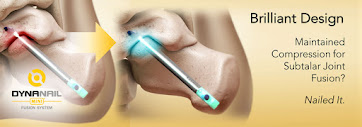Intramedullary Nail Fixation - All You Need to Know
Intramedullary nailing is a type of surgery that repairs broken or diseased bones to keep them stable and help facilitate fusion. In this surgery, a permanent nail, i.e., an intramedullary nail or a rod is placed in the centre of the bone, so it would enable you to put weight on the bone. Typically this bone fixation procedure is carried out mostly in the Femur, Tibia, hip, and Humerus.
Evolution of Hindfoot Fusion Intramedullary
Nail Fixation
During the 1st generation
of hindfoot fusion nailing surgery, there was no application of compression;
instead, the nails were locked into the bone with screws. The 2nd
generation nail fixation applied external manual compression through the frame.
3rd generation introduced internal compression by using an internal
screw to press against the calcaneal screw. However with all these earlier
generation nails, the bones are able to retain compression after the
instruments are removed but would lose compression upon any bone resorption or
settling.
What should you know about the surgery?
- Preparation of the surgery
Consult with your physician to know about how you should prepare for the intramedullary nailing surgery. The physician will inform you which medications you should consume before the surgery. You might also get antibiotics through IV to prevent any bacterial infection.
- The surgery’s working procedure
You will be given
anaesthesia prior to the surgery to keep you from pain during the surgical
procedure. Typically the surgery requires creating small incisions in your
skin. The surgeon puts a guidewire through the incision through the centre of
the bone, and then drills to make space for the nail implant.
After aligning
the intended bones to be stabilized or fused, the intramedullary nail is inserted into the hollow area of the bones. Then the screws are
locked on both ends of the nail to lock into place. For completion, the
incisions are closed off with stitches or staples.
Contact MedShape Inc. to know more information
about Intramedullary bone fixation.
Original Source: Intramedullary Nail Fixation - All You Need to Know




Comments
Post a Comment